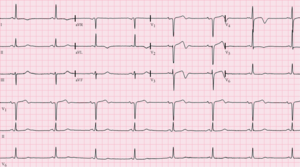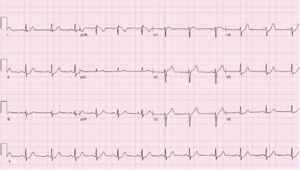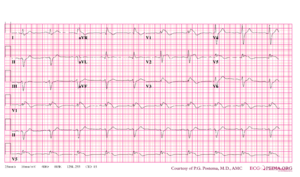Eponymous ECG's: Difference between revisions
mNo edit summary |
|||
| Line 1: | Line 1: | ||
==Wellens ECG== | ==Wellens ECG== | ||
[[File:wellens.png|thumb|right|An example of 12 lead Wellens' ECG]] | [[File:wellens.png|thumb|right|An example of 12 lead Wellens' ECG]] | ||
Wellens' ECG (sometimes referred to as Wellens syndrome or sign) is an ECG manifestation of proximal left anterior descending stenosis in patients with acute coronary syndrome. It is characterized by symmetrical, often deep (>2 mm), T wave inversions in the anterior precordial leads. A less common variant is biphasic T wave inversions in the same leads. | Wellens' ECG (sometimes referred to as Wellens syndrome or sign) is an ECG manifestation of proximal left anterior descending stenosis in patients with acute coronary syndrome. It is characterized by symmetrical, often deep (>2 mm), T wave inversions in the anterior precordial leads. A less common variant is biphasic T wave inversions in the same leads. <cite>wellens</cite>{{clr}} | ||
<cite> | |||
==De Winter ECG== | ==De Winter ECG== | ||
[[File:dewinter.png|thumb|right|An example of 12 lead De Winter ECG]] | [[File:dewinter.png|thumb|right|An example of 12 lead De Winter ECG]] | ||
| Line 14: | Line 13: | ||
#dewinter pmid=18987380 | #dewinter pmid=18987380 | ||
#wellens pmid=6121481 | #wellens pmid=6121481 | ||
#brugada pmid=1309182 | |||
</blblio> | </blblio> | ||
Revision as of 12:50, 15 January 2016
Wellens ECG
Wellens' ECG (sometimes referred to as Wellens syndrome or sign) is an ECG manifestation of proximal left anterior descending stenosis in patients with acute coronary syndrome. It is characterized by symmetrical, often deep (>2 mm), T wave inversions in the anterior precordial leads. A less common variant is biphasic T wave inversions in the same leads. [1]
De Winter ECG
The De Winter ECG is sometimes seen in myocardial infarction with proximal LAD occlusion. It is rather rare (2% of cases). There is no anterior ST segment elevation. Instead the ST segment shows a 1- to 3-mm upsloping ST-segment depression at the J point in leads V1 to V6 that continues into tall, positive symmetrical T waves. The QRS complexes are usually not widened or only slightly widened, and sometimes there is a loss of precordial R-wave progression. In most patients there is a 1- to 2-mm ST-elevation in lead aVR. [2] Prof. Robert de Winter is an intervention cardiologist in the Academic Medical Center in Amsterdam, the Netherlands.
Brugada syndrome
The Brugada syndrome is an hereditary disease that is associated with high risk of sudden cardiac death. It is characterized by typical ECG abnormalities: ST segment elevation in the precordial leads (V1 - V3).[3]
References
<biblio>
- dewinter pmid=18987380
- wellens pmid=6121481
- brugada pmid=1309182
</blblio>


